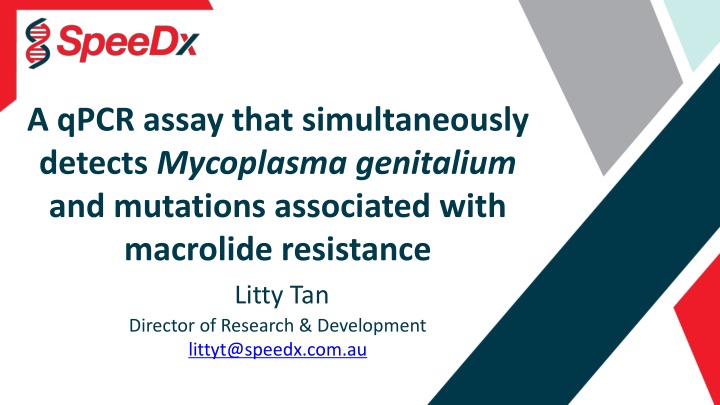
Advanced qPCR Assay for Mycoplasma Genitalium Detection and Macrolide Resistance Mutations
"Explore a groundbreaking qPCR assay developed by Litty Tan and collaborators in Australia to simultaneously detect Mycoplasma genitalium and mutations linked to macrolide resistance. Learn about the clinical associations of MG, challenges in current practice, and limitations of existing testing methods. Discover the innovative approach to address these issues and enhance diagnostic capabilities in managing MG infections."
Download Presentation

Please find below an Image/Link to download the presentation.
The content on the website is provided AS IS for your information and personal use only. It may not be sold, licensed, or shared on other websites without obtaining consent from the author. If you encounter any issues during the download, it is possible that the publisher has removed the file from their server.
You are allowed to download the files provided on this website for personal or commercial use, subject to the condition that they are used lawfully. All files are the property of their respective owners.
The content on the website is provided AS IS for your information and personal use only. It may not be sold, licensed, or shared on other websites without obtaining consent from the author.
E N D
Presentation Transcript
A qPCR assay that simultaneously detects Mycoplasma genitalium and mutations associated with macrolide resistance Litty Tan Director of Research & Development littyt@speedx.com.au
Investigators Royal Women s Hospital (RWH), Melbourne, Australia Sepehr Tabrizi Jimmy Twin Jenny Su Marin Poljak Suzanne Garland Melbourne Sexual Health Centre (MSHC), Australia Catriona Bradshaw Christopher Fairley SpeeDx Samantha Walker Elisa Mokany Disclosure SpeeDx is the developer and manufacturer of the ResistancePlus assay evaluated in this study 2
Mycoplasma genitalium (MG) clinical association General population Detected in 1-3.3% Exact burden of disease is unknown Men Strongly associated with non-gonococcal urethritis (NGU) (6-50%) Other conditions: Proctitis, Balanitis, Chronic prostatitis, Acute epididymitis Women Strongly associated with cervicitis (5-20%) Other conditions: Endometritis, Pelvic inflammatory disease, Preterm birth
Challenges of current clinical practice Empiric treatment of NGU & cervicitis Doxycycline: poor efficacy, microbiological cure rate of MG is 30-40% Azithromycin: higher efficacy, 1 g single dose has 85% cure rate Decreasing overall cure rates with azithromycin due to resistance Where 1 g azithromycin is used to treat NGU, macrolide resistance is ~30-40% Resistance is associated with mutations in 23S rRNA gene A2058G, A2059G, A2058T, A2058C, A2059C (E. coli numbering) Mutations prevent azithromycin binding and inhibiting translation
Current limitations of MG testing MG detection In house qPCR tests and recent commercially available CE marked tests Macrolide resistance detection (23S rRNA mutation) Strongly recommended by 2016 European guidelines on MG infections Methods for mutation detection Sequencing Costly and generally not convenient for routine diagnostics High resolution melt analysis (HRMA) Separate assay to MG detection, not easy to analyse Fluorescence resonance energy transfer (FRET) Lacking in sensitivity
ResistancePlus MG Combined detection of MG and mutations associated with macrolide resistance in a multiplex qPCR test
PlexZyme detection technology Universal probe F F F F Q Q F Q PlexZyme Target amplicon High Specificity, High Sensitivity, Universal Probe Mokany et al JACS (2010) & Clin Chem (2013)
PlexPrime for mutation detection Enhanced specificity and superior multiplexing Mismatch increases specificity Mismatched Mutation specific PlexPrimer Plex to target Insert Matches mutation X X X X X X Standard primer Increases specificity Differs for each mutant Signal Probe PlexZyme Mutation specific PlexZyme detection PlexPrime amplicon Mutation specific PlexPrime AND Mutation specific PlexZyme detection Patent: WO 2013/123552
ResistancePlus MG Sensitivity and specificity Target MG detection (MgPa) Channel 1 A2058G A2059G 23S rRNA mutation Channel 2 A2058T A2058C A2059C Internal Control Channel 3 9
ResistancePlus MG Sensitivity and specificity Target Sensitivity (copies/reaction) MG detection (MgPa) 10 Channel 1 A2058G 12 A2059G 10 23S rRNA mutation Channel 2 A2058T 10 A2058C 10 A2059C 15 Internal Control n/a Channel 3 Specific against other targets M. hominis, U. parvum, U. urealyticum, C. trachomatis, N. gonorrhoeae, T. vaginalis, S. pneumoniae, M. pneumoniae, M. gallisepticum, E. coli, E. faecalis, P. aeruginosa, K. pneumoniae,HSV-1, HSV-2 Targets 10
Prospective study: ResistancePlus MG Sample cohort 1089 samples received Nov 2015-Dec 2015 at RWH (Melbourne, Australia) Royal Women s Hospital, Melbourne Sexual Health Centre, and external sites Symptomatic and asymptomatic males and females Urine/ Cervical/ vaginal swab Anal swab Sample numbers urethral swab Male 354 34 n/a 388 Female 203 2 496 701 Total 557 36 496 1089
Prospective study: ResistancePlus MG Clinical results MG detection In house qPCR (16S rRNA) % 95% CI + - Total Sensitivity 98.5 91.7 to 99.9 + 64 0 64 Specificity 100.0 99.6 to 100.0 SpeeDx - 1 1024 1025 PPV 100.0 94.4 to 100.0 Total 65 1024 1089 NPV 99.9 99.5 to 100.0 MG prevalence Overall 6.0%, Male 10.8%, Female 3.3% 12
Prospective study: ResistancePlus MG Clinical results 23S rRNA mutant detection Sanger Sequencing % 95% CI Mutant Wild type Total Sensitivity 100.0 90.8 to 100.0 Mutant 38 1 39 Specificity 96.2 80.4 to 99.9 SpeeDx Wild type 0 25 25 PPV 97.4 86.5 to 99.9 Total 38 26 64* NPV 100.0 86.3 to 100.0 * Only includes MG positive samples by both methods MG 23S rRNA mutant prevalence Overall 63.1%, Male 81.0%, Female 30.4% Highly multiplexed test with excellent clinical sensitivity and specificity 13
ResistancePlus MG and future directions Potential to improve patient management and improve clinical outcomes Evaluation with PHE Sexually Transmitted Bacterial Reference Laboratory CE marking in July Other ResistancePlus assays in development MG fluoroquinolone resistance Gonorrhoea macrolide resistance Please come and talk to us about MG and other tests!
